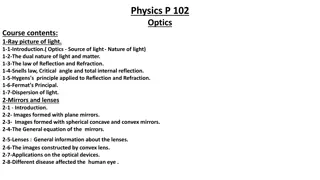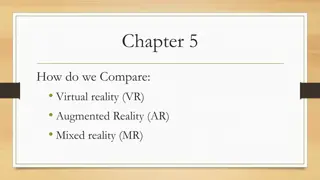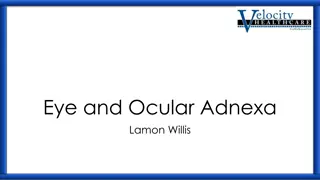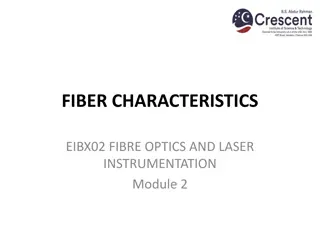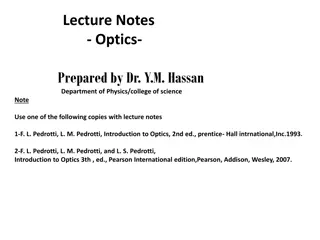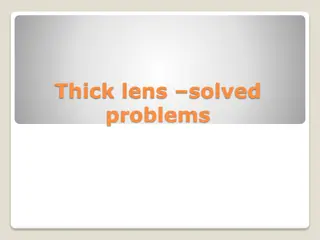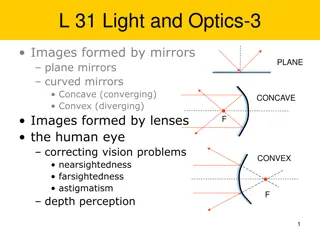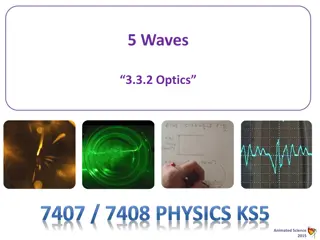Understanding The Optics of Vision: From Magnifying Glasses to Eyeball Anatomy
Explore the fascinating world of optics and vision, from the use of diverging lenses as magnifying glasses to the intricate anatomy of the human eye. Learn about image formation in cameras, the refractive power of lenses, nearsightedness, and prescription lenses for correcting vision issues such as myopia. Delve into concepts like refractive power, accommodation, focal length changes in the eye's lens, and more.
Download Presentation

Please find below an Image/Link to download the presentation.
The content on the website is provided AS IS for your information and personal use only. It may not be sold, licensed, or shared on other websites without obtaining consent from the author. Download presentation by click this link. If you encounter any issues during the download, it is possible that the publisher has removed the file from their server.
E N D
Presentation Transcript
Can a Diverging Lens used as magnifying glass?
The Human Eye Anatomy: The eyeball is approximately spherical with a diameter of about 25 mm, or 2.5 cm. Light enters the eye through a transparent membrane (the cornea, n = 1.38 ). Cornea covers a clear liquid region (the aqueous humor, n = 1.33 ), behind which is a diaphragm (the iris ), the lens (n = 1.4), a region filled with a jelly-like substance (the vitreous humor, n = 1.34 ), and, finally, the retina. The retina is the light-sensitive part of the eye, consisting of millions of structures called rods and cones. When stimulated by light, these structures send electrical impulses via the optic nerve to the brain, which interprets the image on the retina.
Relaxed and Tensed Lens (a) When fully relaxed, the lens of the eye has its longest focal length, and an image of a very distant object is formed on the retina. (b) When the ciliary muscle is tensed, the lens has a shorter focal length.
Near point and Far point The near point is the point nearest the eye at which an object can be placed and still produce a sharp image on the retina. The far point of the eye is the location of the farthest object on which the fully relaxed eye can focus. For normal eyesight, the near point is close to 25 cm and far point is infinity. Accommodation is the process in which the lens changes its focal length to focus on objects at different distances.
The Refractive Power of a Lens The Diopter Optometrists use the concept of refractive power to prescribe lenses.
Nearsightedness A person who is nearsighted (myopic) can focus on nearby objects but cannot clearly see objects far away.
Prescription Lenses A nearsighted person has a far point of 55 cm from the eyes. What power of (a) contact lenses and (b) spectacle lenses are needed to restore normal vision? Assume the spectacle lens is held 1.50 cm away from the eye by eyeglass frames.
Farsightedness A farsighted (hyperopic) person can usually see distant objects clearly, but cannot focus on those nearby.
Prescription Lenses A farsighted person has a near point located 150 cm from the eyes. What power of (a) contact lenses and (b) spectacle lenses are needed for the person to read a book held 25.0 cm from the eyes. Assume the spectacle lens is held 1.50 cm away from the eye by eyeglass frames.
The Compound Microscope A compound microscope has two convex lenses, an eyepiece as a magnifying glass and an objective.
The Telescope A telescope is an instrument for magnifying distant objects, such as stars and planets. Like a microscope, a telescope consists of an objective and an eyepiece.
Lens Aberrations Spherical Aberration Chromatic Aberration
Spherical Aberration Spherical aberration occurs with converging and diverging lenses made with spherical surfaces. The circle of least confusion is where the most satisfactory image can be formed by the lens. Spherical aberration can be reduced substantially by using a variable-aperture diaphragm to allow only those rays close to the principal axis to pass through the lens.
Chromatic Aberration Chromatic aberration arises because the index of refraction of the material from which the lens is made varies with wavelength. Multiple-lens systems can partially correct chromatic aberrations, but they may require lenses of different materials and add to the expense of optical systems. A lens combination designed to reduce chromatic aberration is called an achromatic lens (from the Greek "achromatos", meaning "without color"). All high-quality cameras use achromatic lenses.


